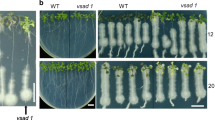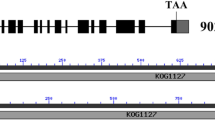Abstract
Anthocyanins are secondary metabolites that play important roles in plant adaption to adverse environments. The anthocyanin biosynthetic pathway is conserved in high plants. Previous studies revealed the significant role of anthocyanins in natural-colorized cotton. However, little is known about the involvement of anthocyanins in the interaction of cotton and pathogen. In this study, a pathogen-induced gene was isolated from Gossypium barbadense that encodes an anthocyanidin synthase protein (GbANS) with dioxygenase structures. GbANS was preferentially expressed in colored tissue. Silencing of GbANS significantly reduced the production of anthocyanins, as well as the cotton’s resistance to Verticillium dahliae. Biochemical studies revealed that GbANS-silenced cotton accumulated more hydrogen peroxide compared to control plants during the V. dahliae invasion process. This accumulation of hydrogen peroxide corresponded with increased cell death around the invasion sites, which in turn accelerated the V. dahliae infection. Taken together, we found that GbANS contributes to the biosynthesis of anthocyanins in cotton and anthocyanins positively regulate cotton’s resistance to V. dahliae.






Similar content being viewed by others
References
Banuett F, Herskowitz I (1996) Discrete developmental stages during teliospore formation in the corn smut fungus, Ustilago maydis. Development 122:2965–2976
Bari R, Jones JD (2009) Role of plant hormones in plant defence responses. Plant Mol Biol 69:473–488
Bednarek P (2014) Chemical warfare or modulators of defence responses-the function of secondary metabolites in plant immunity. Curr Opin Plant Biol 15:407–414
Bochi VC, Barcia MT, Rodrigues D, Godoy HT (2015) Biochemical characterization of dovyalis hebecarpa fruits: a source of anthocyanins with high antioxidant capacity. J Food Sci 80:C2127–C2133
Brefort T, Tanaka S, Neidig N, Doehlemann G, Vincon V, Kahmann R (2014) Characterization of the largest effector gene cluster of Ustilago maydis. PLoS Pathog 10:e1003866
Dubery IA, Meyer R (1996) Specific binding of a Verticillium dahliae phytotoxin to protoplasts of cotton, Gossypium hirsutum. Plant Cell Rep 15:777–780
Fan X, Fan B, Wang Y, Yang W (2016) Anthocyanin accumulation enhanced in Lc-transgenic cotton under light and increased resistance to bollworm. Plant Biotechnol Rep 10:1–11
Feng H et al (2013) Analysis of flavonoids and the flavonoid structural genes in brown fiber of upland cotton. PLoS ONE 8:e58820
Fogelman E, Tanami S, Ginzberg I (2015) Anthocyanin synthesis in native and wound periderms of potato. Physiol Plant 153:616–626
Fradin EF, Thomma BP (2006) Physiology and molecular aspects of Verticillium wilt diseases caused by V. dahliae and V. albo-atrum. Mol Plant Pathol 7:71–86
Fradin EF, Abd-El-Haliem A, Masini L, van den Berg GC, Joosten MH, Thomma BP (2011) Interfamily transfer of tomato Ve1 mediates Verticillium resistance in Arabidopsis. Plant Physiol l156:2255–2265
Gao W et al (2013) Proteomic and virus-induced gene silencing (VIGS) analyses reveal that gossypol, brassinosteroids, and jasmonic acid contribute to the resistance of cotton to Verticillium dahliae. Mol Cell Proteomics 12:3690–3703
Gao W, Long L, Xu L, Lindsey K, Zhang X, Zhu L (2016) Suppression of the homeobox gene HDTF1 enhances resistance to Verticillium dahliae and Botrytis cinerea in cotton. J Integr Plant Biol 58:503–513
Gao W et al (2017) Genome editing in cotton with the CRISPR/Cas9 system. Front Plant Sci 8:1364
Gao W et al (2018) Calcium-dependent protein kinases in cotton: insights into early plant responses to salt stress. BMC Plant Biol 18:15
Giampieri F et al (2018) Overexpression of the anthocyanidin synthase gene in strawberry enhances antioxidant capacity and cytotoxic effects on human hepatic cancer cells. J Agric Food Chem 66:581–592
Hipskind J, Wood K, Nicholson RL (1996) Localized stimulation of anthocyanin accumulation and delineation of pathogen ingress in maize genetically resistant to Bipolaris maydis race O. Physiol Mol Plant Pathol 49:247–256
Iriti M, Rossoni M, Borgo M, Faoro F (2004) Benzothiadiazole enhances resveratrol and anthocyanin biosynthesis in grapevine, meanwhile improving resistance to Botrytis cinerea. J Agric Food Chem 52:4406–4413
Klee HJ (2013) Purple tomatoes: longer lasting, less disease, and better for you. Curr Biol 23:R520–R521
Landi M, Tattini M, Gould K (2015) Multiple functional roles of anthocyanins in plant-environment interactions. Environ Exp Bot 119:4–17
Lehmann S, Serrano M, L’Haridon F, Tjamos SE, Metraux JP (2015) Reactive oxygen species and plant resistance to fungal pathogens. Phytochemistry 112:54–62
Li T, Fan H, Li Z, Wei J, Lin Y, Cai Y (2012) The accumulation of pigment in fiber related to proanthocyanidins synthesis for brown cotton. Acta Physiol Plant 34:813–818
Lu Y et al (2017) Flavonoid accumulation plays an important role in the rust resistance of Malus plant leaves. Front Plant Sci 8:1286
Monagas M et al (2010) Insights into the metabolism and microbial biotransformation of dietary flavan-3-ols and the bioactivity of their metabolites. Food Funct 1:233–253
Oliveira MA, Duarte JB, Morello CL, Suassuna ND, Oliveira AB (2016) Mixed inheritance in the genetic control of ramulosis (Colletotrichum gossypii var. cephalosporioides) resistance in cotton. Genet Mol Res 15:1–6
Peixoto H, Roxo M, Krstin S, Röhrig T, Richling E, Wink M (2016) An anthocyanin-rich extract of acai (Euterpe precatoria Mart.) increases stress resistance and retards aging-related markers in Caenorhabditis elegans. J Agric Food Chem 64:1283–1290
Reusche M et al (2014) Infections with the vascular pathogens Verticillium longisporum and Verticillium dahliae induce distinct disease symptoms and differentially affect drought stress tolerance of Arabidopsis thaliana. Environ Exp Bot 108:23–37
Roy SJ, Negrao S, Tester M (2014) Salt resistant crop plants. Curr Opin Biotechnol 26:115–124
Santos-Buelga C, Mateus N, De Freitas V (2014) Anthocyanins. Plant pigments and beyond. J Agric Food Chem 62:6879–6884
Shaban M et al (2018) Physiological and molecular mechanism of defense in cotton against Verticillium dahliae. Plant Physiol Biochem 125:193–204
Steyn WJ, Wand SJE, Holcroft DM, Jacobs G (2002) Anthocyanins in vegetative tissues: a proposed unified function in photoprotection. New Phytol 155:349–361
Sun L, Zhu L, Xu L, Yuan D, Min L, Zhang X (2014) Cotton cytochrome P450 CYP82D regulates systemic cell death by modulating the octadecanoid pathway. Nat Commun 5:5372
Tan J, Tu L, Deng F, Hu H, Nie Y, Zhang X (2013) A genetic and metabolic analysis revealed that cotton fiber cell development was retarded by flavonoid naringenin. Plant Physiol 162:86–95
Tanaka S et al (2014) A secreted Ustilago maydis effector promotes virulence by targeting anthocyanin biosynthesis in maize. Elife 3:e01355
Thaler JS, Owen B, Higgins VJ (2004) The role of the jasmonate response in plant susceptibility to diverse pathogens with a range of lifestyles. Plant Physiol 135:530–538
Ullah C et al (2017) Flavan-3-ols are an effective chemical defense against rust infection. Plant Physiol 175:1560–1578
van Kan JA (2006) Licensed to kill: the lifestyle of a necrotrophic plant pathogen. Trends Plant Sci 11(5):247–253
Xiao Y et al (2007) Cotton flavonoid structural genes related to the pigmentation in brown fibers. Biochem Biophys Res Commun 358(1):73–78
Xu L et al (2011) Lignin metabolism has a central role in the resistance of cotton to the wilt fungus Verticillium dahliae as revealed by RNA-Seq-dependent transcriptional analysis and histochemistry. J Exp Bot 62:5607–5621
Xu F et al (2018) Heterogeneous expression of the cotton R2R3-MYB transcription factor GbMYB60 increases salt sensitivity in transgenic Arabidopsis. Plant Cell Tissue Org Cult 133:15–25
Yousuf B, Gul K, Wani A, Singh P (2016) Health benefits of anthocyanins and their encapsulation for potential use in food systems: a review. Crit Rev Food Sci Nutr 56:2223–2230
Yuan D et al (2015) The genome sequence of Sea-Island cotton (Gossypium barbadense) provides insights into the allopolyploidization and development of superior spinnable fibres. Sci Rep 5:17662
Zhang Y et al (2013a) Anthocyanins double the shelf life of tomatoes by delaying overripening and reducing susceptibility to gray mold. Curr Biol 23:1094–1100
Zhang Y et al (2013b) Transcriptome profiling of Gossypium barbadense inoculated with Verticillium dahliae provides a resource for cotton improvement. BMC Genomics 14:637
Zhu Y et al (2015) Functional characterization of an anthocyanidin reductase gene from the fibers of upland cotton (Gossypium hirsutum). Planta 241:1075–1089
Acknowledgements
This work was financially supported by the National Natural Science Foundation of China (31601344, 31701473), and the Ministry of Agriculture of China (2016ZX08009-003).
Author information
Authors and Affiliations
Contributions
LL analyzed and interpreted data and wrote the manuscript. JRZ and FCX performed the experiments. WWY, PL and YG analyzed the data and revised the manuscript. WG designed the study and supervised all of work. CPS revised the manuscript. All authors read and approved the final manuscript.
Corresponding author
Ethics declarations
Conflict of interest
All authors declare that they have no conflicts of interest.
Research involving human and animal participants
This article does not contain any studies with human participants or animals performed by any of the authors.
Additional information
Communicated by Ming-Tsair Chan.
Rights and permissions
About this article
Cite this article
Long, L., Zhao, JR., Xu, FC. et al. Silencing of GbANS reduces cotton resistance to Verticillium dahliae through decreased ROS scavenging during the pathogen invasion process. Plant Cell Tiss Organ Cult 135, 213–221 (2018). https://doi.org/10.1007/s11240-018-1457-y
Received:
Accepted:
Published:
Issue Date:
DOI: https://doi.org/10.1007/s11240-018-1457-y




